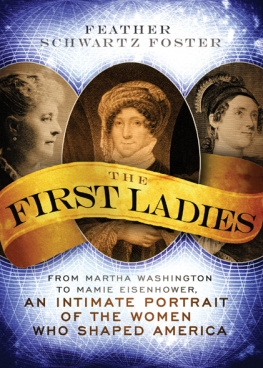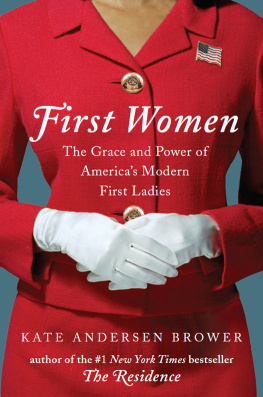Copyright 2011 by Feather Schwartz Foster
Cover and internal design 2011 by Sourcebooks, Inc.
Cover design by Roy Roper/wideyedesign
Cover images wynnter/ iStockphoto.com; Bettmann/CORBIS
All images of First Ladies are courtesy of the Library of Congress.
Sourcebooks and the colophon are registered trademarks of Sourcebooks, Inc.
All rights reserved. No part of this book may be reproduced in any form or by any electronic or mechanical means including information storage and retrieval systemsexcept in the case of brief quotations embodied in critical articles or reviews without permission in writing from its publisher, Sourcebooks, Inc.
This publication is designed to provide accurate and authoritative information in regard to the subject matter covered. It is sold with the understanding that the publisher is not engaged in rendering legal, accounting, or other professional service. If legal advice or other expert assistance is required, the services of a competent professional person should be sought.From a Declaration of Principles Jointly Adopted by a Committee of the American Bar Association and a Committee of Publishers and Associations
Published by Cumberland House, an imprint of Sourcebooks, Inc.
P.O. Box 4410, Naperville, Illinois 605674410
(630) 9613900
Fax: (630) 9612168
www.sourcebooks.com
Library of Congress Cataloging-in-Publication Data
Schwartz Foster, Feather.
The first ladies : From Martha Washington to Mamie Eisenhower, an intimate portrait of the women who shaped America / Feather Schwartz Foster.
p. cm.
Includes bibliographical references.
1. Presidents spousesUnited StatesBiography. I. Title.
E176.2.S37 2011
973.099dc22
[B]
2010041948
Printed and bound in the United States of America.
VP 10 9 8 7 6 5 4 3 2 1
To the Ladies themselves
ACKNOWLEDGMENTS

To the docents of the dozens of presidential sites I have visited over the years, who have cheerfully put up with my zillion questions.
My personal presidential library full of nearly two thousand volumesfar too many to list. Their authors taught me to read and write. And think.
The staff of the Scotch Plains, New Jersey, library, where I was a fixture for years, scribbling away.
The staff of the Williamsburg, Virginia, library, where I am currently a fixture and plan to continue to be for years to come.
To the editors at Sourcebooks, who have been patient with me and more helpful than they realize.
To Dr. Paul C. Nagel, who encouraged me and helped more than he could ever know.
To Ron Pitkin, who believed in me.
To the memory of Laura G. Haywood, who put me on the path and kept after me.
To my dear friend Barbara Lepis, who instinctively asks the right questions.
And finally, to my husband and daughter, who have been sharing me with a bunch of old gals for a very long time.

MARTHA WASHINGTON
17311802
FIRST LADY: 178997

The Domestic Lady W.
It has been said that the best political decision George Washington ever made was to marry the Widow Custis. He was a Virginia militia colonel seeking a career change. Efforts for a commission in the regular British army had been consistently thwarted. Washington determined to focus his attentions on the estate he had inherited from his half brother, but in order to make his Mount Vernon plantation the envy of Fairfax County, he needed an appropriate consort. And it was time. He was twenty-six.
Martha Dandridge Custis was the daughter of well-to-do Virginia gentry on a social and economic par with the Washingtons. Her academic education was modest. She could read, write, and do sufficient arithmetic to manage the household accounts. At seventeen, she married into the wealthy Custis family and was widowed at twenty-six, left with two small children (four and two years old), and one huge estate (more than twenty thousand fertile acres, two hundred slaves, and the scarcest commodity among land-poor planters: a substantial amount of cash). Remarriage was her best option, and Martha required a mate with sufficient property of his own, since she was understandably wary of fortune hunters. She also required someone who would be a kind stepfather and honest manager for her childrens sizable inheritance.
Both of them made fortunate choices for a happy and successful marriage.
Martha was the consummate colonial mistress and hostess, reasonably cultured, and superbly skilled at household management. It would fall to her to supervise the numerous slaves and cottage industries that accounted for a successful plantation. She sewed beautifully, danced the minuet gracefully, was said to set the finest table in northern Virginia. Her kitchen and recipe collection was the envy of her neighbors. She boasted a medical box with all the proper herbs and remedies the eighteenth century could provide, and she took pride and pleasure in caring for others.
The Custis wealth helped to assure Washington a seat in the House of Burgesses, a responsibility he accepted with the usual eighteenth-century noblesse oblige. Within ten years of their marriage, Washington had increased his own holdings to include acreage as far west as the Ohio Valley. Mount Vernon had been renovated and enlarged. Most important, he had established and engaged more than a dozen tenant farmers and craftsmen to provide mills, shipbuilding facilities, a fishing fleet, spinners, and weavers for his ever-growing conglomerate of industries. The Washingtons had become extremely wealthy, thanks to his shrewd business instincts, but they seldom dined alone. Their home was a mecca for friends and neighbors, relations on both sides, and weary travelers. No one was turned away. Their hospitality was known throughout the colony.
Marthas Legacy
Everything Martha Washington did between 1789 and 1797 set a precedent and TONE for future First Ladies determined by her modest gentility and coupled with years of executive skills at plantation-house management. The exquisitely fine line walked between a dreaded monarchy la England and the rabble of democracy la France would find no finer example than that of Lady Washington. Her elegance was simple. Her natural friendliness seeped through the prescribed deportment. The tone she set was completely new. And it was decidedly American.
At the onset of the American Revolution, both George and Martha were forty-three, which was considered well into middle age. War in the eighteenth century was primarily a seasonal affair: spring, summer, and fall. In the winter, armies usually went into winter quarters, and Martha Washington would travel from Mount Vernon with her medicine box and knitting needles to meet her husband wherever he was encamped. She had never before ventured beyond Virginias borders. The exacting general, who was always hard-pressed to maintain his ragtag army, heartily welcomed Mrs. W. and whatever supplies she could bring, which were a godsend. She immediately took charge of seeing to the generals personal comfort, supervising the officers kitchens, and organizing other officers wives to sew, knit, scrape lint for bandages, and make themselves useful. Above all, she had her medicine box for tending the sick and wounded. Come spring, she went home and the war continued.
It would be seven years before Private Citizen and Mrs. Washington could be together again in their beloved Virginia home. Their idyll would not last long. Politics would take center stage in the new nation, and Washington was considered the indispensable man with a new title: president of the United States. There had never been anything like it before.









